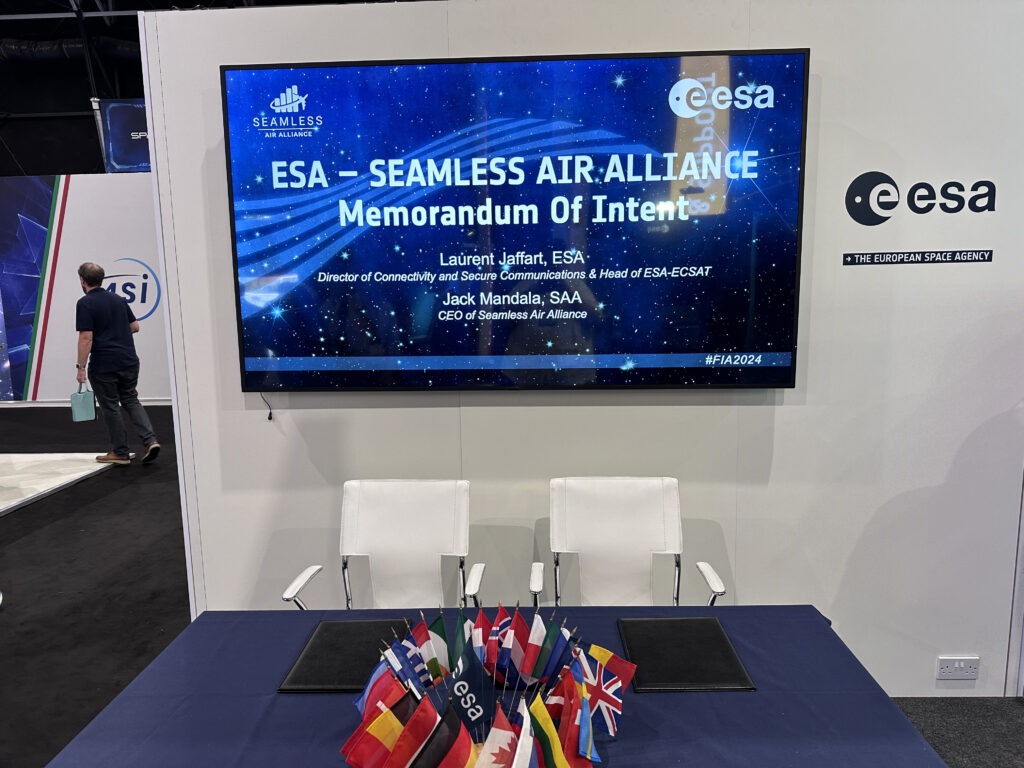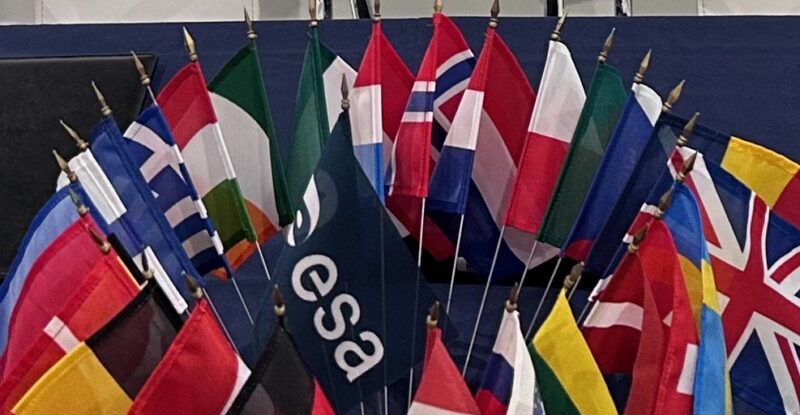FARNBOROUGH — The Seamless Air Alliance — a wide-ranging grouping of airlines, airframers, original equipment manufacturers and suppliers — is working with the European Space Agency (ESA) via a new memorandum of intent, signed at the Farnborough Airshow.
The goal, Seamless chief executive officer Jack Mandala tells Runway Girl Network, is to continue pushing 3GPP (the 3rd Generation Partnership Project) to secure support for cellular-from-space requirements for inflight connectivity, including support for Ku-band and Ka-band frequencies, plus mobile VSAT (very-small-aperture terminal) functionality.
“This agreement, helps give us more clout to keep cellular prioritised among the work items in 3GPP: writing code for Ka and Ku bands, so that we can do cellular in space. If we’re all doing cellular in space, it’s a common modem… that’s the end goal,” Mandala tells RGN.
Much of the work here is around interoperability, technological agnosticism, standards and ecosystem defragmentation.
“Airbus, Boeing, every airline out there, would like to get rid of all of the proprietary modems and, over time, slowly move to a common modem — and that modem should be a cellular modem. The cellular industry has been working at this for over 50 years,” Mandala says, highlighting that one key issue is around scale. “3GPP has been writing standards that all of the industry uses, so you’ve got this tiny little aviation business, with 30,000 aircraft worldwide, and then you have the cellular industry with 17 billion devices today.”
Balancing the needs of terrestrial and non-terrestrial networks is, as a result, complex, especially given the technologically diverse install base aboard aircraft and the long periods between connectivity system upgrades.
“The idea of working with ESA and the idea of the non-terrestrial network group is to merge the best of satellite, through ubiquity of satellites: we’ve got so many satellites up there, with the tried and true terrestrial networks, so that there’s a natural seamless mobility between the two,” Mandala explains.
“In line with [Airbus’] HBCplus and Boeing’s plan to do the same thing, you get to commonality on the production line — it makes everything easier from a economy of scale [to] interoperability.”

Seamless Air Alliance’s mission aligns with ESA’s so-called Space for 5G/6G and Sustainable Connectivity, which forms part of the Advanced Research in Telecommunications Systems (ARTES) programme. Image: John Walton
While the current set of modems and their related antennas will be used for the current generation of inflight connectivity offerings, Mandala predicts a gradual convergence in the next generation of technology.
“I think you’ll see the 3GPP modem sneak in there as a secondary modem, and more and more traffic over time will migrate to that, and you will have truly the vision that Seamless had from the beginning of seamless mobility: it doesn’t matter whether you’re on an aircraft, or in Ohio, or in the UK. Your device talks the same language,” he suggests.
Wider convergence between terrestrial and non-terrestrial usage across the 5G and 6G technology generations is likely to accelerate.
Beyond this, of course, convergence around billing, payment and commercial terms will make sense. Inflight connectivity has become a hygiene factor aboard many airlines, with more and more shifting to full-aircraft free, free for premium classes, app-enabled free or ad-supported freemium models.
Similarly, in a growing number of regions, full and free interoperable roaming (the EU model) or regional roaming (models such as SingTel’s regional/global options) are becoming attractive. At the same time, the use of cheap time-limited data eSIMs — whether direct from operators or via clearinghouse apps like Airalo and Mobimatter — is shifting from bleeding-edge adopters to regular travellers.
“We’ve got to get some of the commercial solved, where mobile network operators are willing to subsidise to some degree and write that off against their subscriber losses or retention of subscribers. That’s one of the largest fees for mobile network operators: subscriber acquisition costs. If that costs $400, and they can subsidise your inflight connectivity, and that makes you last longer as a customer, the payback is huge,” Mandala says. “I think they realised that and I think it’s just got to settle out and it’ll settle out over time. Market forces have to come into play here and figure out the balance between not charging so much of a premium.”
Some regulators may not wait until the invisible hand of the market starts to act. With the forthcoming second von der Leyen Commission in Europe yet to be formalised, the question is whether Margrethe Vestager — currently both digital and competition commissioner — will be reappointed, and indeed whether both portfolios will be held by the same person.
For its part, ESA is proud to join the Seamless Air Alliance (SAA). “It enables us to share the impact that space-based connectivity can have on Earth and in the air,” notes Laurent Jaffart, ESA director of connectivity and secure communications. “The SAA provides a unique platform for us to continue our engagement with the aviation industry and learn from its members and contribute to its global reach.”
Related Articles:
- Kontron M&A ensures quiet giant has total ownership of systems
- RGN Premium: An interview with Seamless’ Jack Mandala and Peter Lemme
- Seamless member Kontron pushes for common aero modem form factor
- Seamless details work with GSMA to support frictionless inflight Wi-Fi
- ST Engineering iDirect breaks new ground to support New Space
- Airbus and Boeing drive IFC interoperability via Seamless Air Alliance
Featured image credited to John Walton











